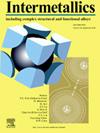The disorder-order transition of FeCuPt nanoparticles with various Cu content
IF 4.3
2区 材料科学
Q2 CHEMISTRY, PHYSICAL
引用次数: 0
Abstract
The effect of adding a third-element on disorder-order transition of FePt has been demonstrated using FeCuPt alloy as a model. The introduction of Cu leads to an increase in the ordering degree, and a moderate amount of Cu enhancing the most. Density Functional Theory calculations indicate that the disorder-order transition in FePt is influenced by the ordering temperature and vacancy formation energy. FePtCu alloy with a moderate Cu content exhibits the lowest vacancy formation energy in the L10-phase, which promotes the atom diffusion during annealing and resulting in a higher ordering degree. This study summarizes the annealing temperature, time, and thermodynamic or kinetic conditions required to achieve L10-FePtX alloy with superior ordering degrees. The findings offer valuable insights for selecting suitable third-elements and annealing parameters to produce L10-FePtX alloy with enhanced ordering degrees.
不同铜含量的铁铜铂纳米粒子的无序阶跃转变
以 FeCuPt 合金为模型,证明了添加第三元素对 FePt 无序有序转变的影响。铜的引入会导致有序度的增加,而适量的铜对有序度的影响最大。密度泛函理论计算表明,FePt 的无序-有序转变受有序温度和空位形成能的影响。适量铜含量的 FePtCu 合金在 L10 相表现出最低的空位形成能,这促进了退火过程中的原子扩散,从而导致更高的有序度。本研究总结了获得具有较高有序度的 L10-FePtX 合金所需的退火温度、时间、热力学或动力学条件。研究结果为选择合适的第三元素和退火参数以生产具有更高有序度的 L10-FePtX 合金提供了有价值的见解。
本文章由计算机程序翻译,如有差异,请以英文原文为准。
求助全文
约1分钟内获得全文
求助全文
来源期刊

Intermetallics
工程技术-材料科学:综合
CiteScore
7.80
自引率
9.10%
发文量
291
审稿时长
37 days
期刊介绍:
This journal is a platform for publishing innovative research and overviews for advancing our understanding of the structure, property, and functionality of complex metallic alloys, including intermetallics, metallic glasses, and high entropy alloys.
The journal reports the science and engineering of metallic materials in the following aspects:
Theories and experiments which address the relationship between property and structure in all length scales.
Physical modeling and numerical simulations which provide a comprehensive understanding of experimental observations.
Stimulated methodologies to characterize the structure and chemistry of materials that correlate the properties.
Technological applications resulting from the understanding of property-structure relationship in materials.
Novel and cutting-edge results warranting rapid communication.
The journal also publishes special issues on selected topics and overviews by invitation only.
 求助内容:
求助内容: 应助结果提醒方式:
应助结果提醒方式:


